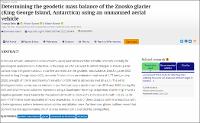Determining the geodetic mass balance of the Znosko glacier (King George Island, Antarctica) using an unmanned aerial vehicle
Fecha
2023-01-09Colecciones
- Artículo científico [171]
Recurso(s) relacionado(s)
https://doi.org/10.1080/2150704X.2023.2165419Resumen
In the last decade, unmanned aerial vehicles (UAVs) have been used for scientific research specially for glaciological applications in Antarctica. In the study an UAV was used to detect changes in Znosko glacier surface, map the glacier contour, snow line and estimate the geodetic mass balance. Znosko glacier (ZG) located in King George Island (KGI), Antarctic Peninsula has an estimated total area of 1.77 km2 (January 2020), a length of 1.9 km and maximum elevation of 300 metres above sea level (m a.s.l.). The aerial photogrammetric survey was carried out in two field campaigns (austral summer 2019 and 2020) during the XXVI and XXVII Peruvian Antarctic Operation using a Quadcopter for image acquisition. Our findings reveal a negative geodetic mass balance for the periods 2019–2012, 2020–2019 and 2020–2012 with −15.25, −2.76 and −17.97 metre water equivalent (m w.e.) respectively. Analysis of these datasets confirm a mass loss with a heterogeneous pattern between accumulation and ablation zone. Furthermore, glacier outlines reveal that ZG front has lost approximately 3% of its area between 2012 and 2020 by calving effect.
El ítem tiene asociados los siguientes ficheros de licencia:








